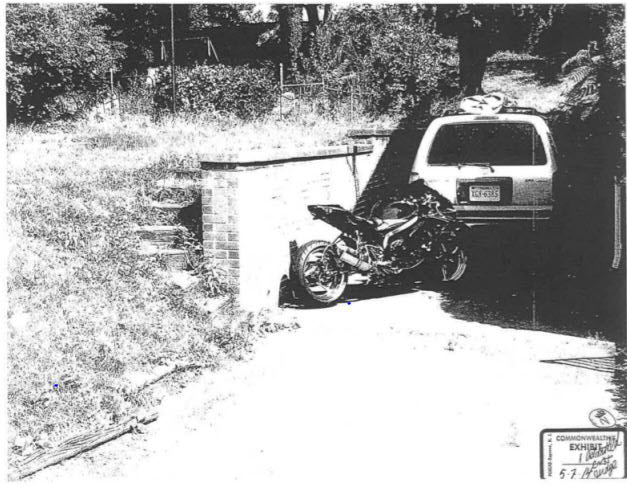
An officer sees a motorcycle that he has probable cause to believe is stolen parked in the suspect’s driveway. The motorcycle is partially covered by a tarpaulin. May the officer lawfully walk into the driveway without the permission of the suspect or any other resident and lift the tarp to read the license plate and VIN number on the motorcycle?
No, he may not. The United States Supreme Court held yesterday in Collins v. Virginia, 584 U.S. ___ (2018) that such a search violates the Fourth Amendment.
More facts. Two officers working alone on two separate occasions attempted to stop the driver of a distinctive orange and black motorcycle for traffic violations. On both occasions, the driver eluded the officers. The officers conferred, investigated and determined that the motorcycle was likely stolen and in the possession of Ryan Collins. They found photographs on Collins’ Facebook profile of an orange and black motorcycle parked at the top of a driveway of a house. They tracked down the address of the house, which was rented by Collins’ girlfriend, and where Collins stayed a few nights each week. One of the officers went to the house and saw the motorcycle parked in a partially enclosed area at the top of the driveway, where it was covered with a white tarpaulin. The area where the motorcycle was parked was enclosed on two sides with a brick wall about the height of a car and on a third side by the house. The officer walked up the driveway, into the enclosed area, and pulled off the tarp. He ran a search of the motorcycle’s license plate and VIN number, which confirmed that the motorcycle was stolen. After gathering this information and taking a picture of the motorcycle, the officer replaced the tarp and returned to his car, which was parked on the street, where he waited for Collins to return.
When Collins came home, the officer walked up to the front door of the house and knocked. Collins answered, agreed to speak to the officer, and admitted that the motorcycle was his and that he bought it without a title. The officer arrested him, and he was later indicted for receiving stolen property.
Procedural history. Collins moved to suppress the evidence that the officer obtained in the warrantless search. He argued that the officer had trespassed on the curtilage of the house to conduct an investigation in violation of the Fourth Amendment. The trial court denied the motion, and Collins was convicted. The Court of Appeals of Virginia affirmed, concluding that “‘numerous exigencies’” justified the officer’s entry onto the property and the moving of the tarp. Slip op. at 3. The Supreme Court of Virginia affirmed for different reasons, concluding that the officer had probable cause to believe the motorcycle was contraband, and that the warrantless search was therefore justified. The United States Supreme Court granted certiorari and reversed. Justice Sotomayor wrote the opinion of the court, which was joined by seven other justices.
Analysis. The Court characterized the issues in Collins as arising at the intersection of two components of the court’s Fourth Amendment jurisprudence: the automobile exception to the warrant requirement and the protection extended to the curtilage of a home.
Automobile exception. The automobile exception to the warrant requirement permits warrantless searches of vehicles that are supported by probable cause. That exception is based on two rationales: (1) the ready mobility of vehicles; and (2) the pervasive regulation of such conveyances. No such general exception to the warrant requirement applies to the search of a home or its curtilage, which do not share the special characteristics of vehicles that undergird the automobile exception.
Warrant generally required to search a house and its curtilage. Homes, in contrast to vehicles, are “‘first among equals’” when it comes to the Fourth Amendment. Slip op. at 5. Warrantless searches of homes, including the areas immediately surrounding them, known as the curtilage, are presumptively unreasonable even when supported by probable cause.
The carport was curtilage. The Court readily concluded that the area of the driveway where the motorcycle was housed was curtilage. It sat at the top of the driveway and was positioned behind the front perimeter of the house. A side door from this area led into the house. A visitor headed to the front door would step off the driveway before reaching this partially enclosed area.
The automobile exception did not justify the invasion of the curtilage. The Court said that a slight alteration of the facts confirmed that this was an “easy case.” Slip op. at 7. Imagine, it posited, that the motorcycle was parked in the living room, visible through a window to a passerby on the street. And imagine that the officer had probable cause to believe the motorcycle was involved in a traffic infraction. Could the officer, without a warrant, enter the house to search the motorcycle? “Surely not,” was the court’s answer. Slip op. at 7.
That’s because the automobile exception permits the search of the vehicle but does not independently permit an officer to invade space otherwise protected by the Fourth Amendment. So, just as the officer could not enter the house without a warrant on the alternative facts, he could not, on the facts in Collins, lawfully enter the carport to access the motorcycle there. The court explained:
To allow an officer to rely on the automobile exception to gain entry into a house or its curtilage for purposes of conducting a vehicle search would unmoor the exception from its justifications, render hollow the core of Fourth Amendment protection the Constitution extends to the house and its curtilage, and transform what was meant to be an exception into a tool with far broader application.
Slip. op. at 9.
Precedent and practicality do not require otherwise. The Court rejected Virginia’s argument that precedent, including Scher v. United States, 305 U.S. 251 (1938), in which it had upheld as lawful an officer’s warrantless search of a car in the defendant’s garage, dictated a different result. The court characterized Scher’s reasoning as “case specific and imprecise” and said that it was “best regarded as a factbound case.” Slip op. at 12. The Court also made short work of Virginia’s request that it limit the full Fourth Amendment protections afforded to the curtilage to fixed, enclosed structures inside the curtilage like a garage. Such a rule, in the view of the Court, is unnecessary and mistakenly conflates the ability to see inside curtilage from a lawful vantage point with the right to enter it. Moreover, such a distinction would grant constitutional rights to people who could afford garages but deprive that right to those whose vehicles were stored on their property, next to their homes, in open areas.
What’s next for Collins. The Supreme Court decision clearly is a victory for Collins. But it does not necessarily mean that his conviction will be reversed. The Court remanded the case to state court for a determination of whether the officer’s warrantless intrusion into the curtilage may have been reasonable on other grounds, such as the exigent circumstances exception to the warrant requirement.
A concurrence, and a dissent. Justice Thomas joined the majority opinion, but wrote a concurring opinion expressing his skepticism regarding the Court’s authority to impose the exclusionary rule on the States. He said the court should revisit its holding in Mapp v. Ohio, 367 U.S. 643 (1961), that the States must apply the exclusionary rule in light of modern precedents that “reject Mapp’s essential premise that the exclusionary rule is required by our Constitution.” Slip op. at 9 (Thomas, J., concurring).
Justice Alito dissented from the majority opinion. He wrote that “[a]n ordinary person of common sense” would react to the Court’s decision the way Mr. Bumble responded in Oliver Twist: If that is the law, “‘the law is an ass—an idiot.’” Slip op. at 2 (Alito, J., dissenting). Yet, Justice Alito explained, the Fourth Amendment is neither ass nor idiot. Instead, “[i]ts hallmark is reasonableness,” and he would have upheld the search as reasonable based on the automobile exception, which recognizes the exigencies categorically associated with mobile vehicles, and a case-specific inquiry into the degree of intrusion on privacy, which, on these facts, was negligible.


